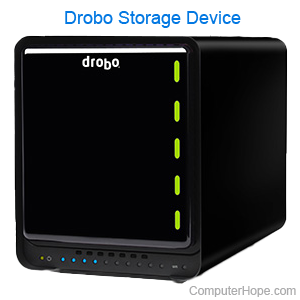External storage

More commonly called an external drive, external storage is storage that's not part of the internal parts (external) of a computer. These drives often connect to the computer using USB (universal serial bus), eSATA, or FireWire connection. The picture shows a Drobo, an example of a popular external storage solution.
Examples of external storage devices
The following list is of external storage devices used over the evolution of the computer. Clicking any of these links open further information about that external storage device.
Some devices mentioned below could use an internal reader. For example, a floppy disk drive could be an internal drive that reads an external storage floppy disk. Also, new computers that no longer support floppy drives could use an external USB floppy drive that would make the drive and diskette external.
Why is external storage used?
This section lists advantages to using an external storage device with a computer.
- Easy way to add additional storage or options to your computer without having to open the computer.
- With an external hard drive, you can store a lot of data for backup or to move between computers.
- An external disc drive can allow a computer without a disc drive to read CDs, DVDs, or other discs.
- Devices like the Drobo can give your computer additional features such as RAID (redundant array of independent disks) help keep your data protected.
- Easy method of transferring files from one computer to another using a sneakernet.
How do you access external storage?
Once connected, external storage is treated the same as internal storage (e.g., your hard drive) on your computer. For example, if you're connecting a USB thumb drive to a computer, it appears as a new drive letter in Explorer. If the next available drive letter was F:, the F: drive should appear in Explorer. Once visible, you can double-click the drive letter to open and browse the files on the thumb drive.
External storage drives that have not yet been formatted (e.g., new external hard drive) must be set up before it's accessible on the computer. For help with setting up a new hard drive, see: How to set up a hard drive and partition in Windows.
External storage vs. remote storage
Although remote storage is external, it should not be confused with external storage. Remote storage is accessed over a network and is often far away from the computer. For example, an office may have a NAS (network-attached storage) in a server closet that can be accessed and used by any network computer. See our remote storage page for further information.
